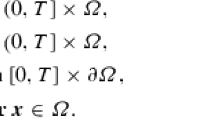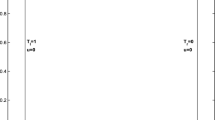Abstract
In this study, we present a second-order time-accurate unconditionally stable numerical method for a gradient flow for the Modica–Mortola functional with an equispaced multiple well potential. The proposed second-order time-accurate unconditionally stable numerical method is based on the operator splitting method. The nonlinear and linear terms in the gradient flow are solved analytically and using the Fourier spectral method, respectively. The numerical solutions in each step are bounded for any time step size and the overall scheme is temporally second-order accurate. We prove theoretically the unconditional stability and boundedness of the numerical solutions. In addition, several numerical tests are conducted to demonstrate the performance of the proposed method.












Similar content being viewed by others
Data Availability
Enquiries about data availability should be directed to the authors.
References
Du, Q., Feng, X.: The phase field method for geometric moving interfaces and their numerical approximations. Handb. Numer. Anal. 21, 425–508 (2020)
Garcia-Cardona, C., Merkurjev, E., Bertozzi, A.L., Flenner, A., Percus, A.G.: Multiclass data segmentation using diffuse interface methods on graphs. IEEE Trans. Pattern Anal. Mach. Intell. 36(8), 1600–1613 (2014)
Giga, Y., Okamoto, J., Uesaka, M.: A finer singular limit of a single-well Modica-Mortola functional and its applications to the Kobayashi-Warren-Carter energy. Adv. Calc. Var. 16(1), 163–82 (2021)
Gong, Y., Zhao, J., Wang, Q.: An energy stable algorithm for a quasi-incompressible hydrodynamic phase-field model of viscous fluid mixtures with variable densities and viscosities. Comput. Phys. Commun. 219, 20–34 (2017)
Gong, Y., Zhao, J., Wang, Q.: Second order fully discrete energy stable methods on staggered grids for hydrodynamic phase field models of binary viscous fluids. SIAM J. Sci. Comput. 40(2), B528–B553 (2018)
Ham, S., Hwang, Y., Kwak, S., Kim, J.: Unconditionally stable second-order accurate scheme for a parabolic sine-Gordon equation. AIP Adv. 12(2), 025203 (2022)
Hötzer, J., Reiter, A., Hierl, H., Steinmetz, P., Selzer, M., Nestler, B.: The parallel multi-physics phase-field framework Pace3D. J. Comput. Sci. 26, 1–12 (2018)
Jin, B., Xu, Y.: Adaptive reconstruction for electrical impedance tomography with a piecewise constant conductivity. Inverse Probl. 36(1), 014003 (2019)
Jeong, D., Kim, J.: An explicit hybrid finite difference scheme for the Allen-Cahn equation. J. Comput. Appl. Math. 340, 247–255 (2018)
Jung, Y.M., Kang, S.H., Shen, J.: Multiphase image segmentation via Modica-Mortola phase transition. SIAM J. Appl. Math. 67(5), 1213–1232 (2007)
Kim, H., Yun, A., Yoon, S., Lee, C., Park, J., Kim, J.: Pattern formation in reaction-diffusion systems on evolving surfaces. Comput. Math. Appl. 80, 2019–2028 (2020)
Lee, H.G.: A semi-analytical Fourier spectral method for the Swift-Hohenberg equation. Comput. Math. Appl. 74(8), 1885–1896 (2017)
Lee, H.G., Shin, J., Lee, J.Y.: Energy quadratization Runge-Kutta scheme for the conservative Allen-Cah equation with a nonlocal Lagrange multiplier. Appl. Math. Lett. 132, 108161 (2022)
Li, C., Huang, Y., Yi, N.: An unconditionally energy stable second order finite element method for solving the Allen-Cahn equation. J. Comput. Appl. Math. 353, 38–48 (2019)
Li, D., Quan, C., Xu, J.: Stability and convergence of strang splitting. Part I: Scalar Allen-Cahn equation. J. Comput. Phys. 458, 111087 (2022)
Li, Y., Yoon, S., Wang, J., Park, J., Kim, S., Lee, C., Kim, J.: Fast and efficient numerical finite difference method for multiphase image segmentation. Math. Probl. Eng. 2021, 1–23 (2021)
Li, Y., Kim, J.: Multiphase image segmentation using a phase-field model. Comput. Math. Appl. 62(2), 737–745 (2011)
Ma, R., Sun, W.: FFT-based solver for higher-order and multi-phase-field fracture models applied to strongly anisotropic brittle materials. Comput. Meth. Appl. Mech. Eng. 362, 112781 (2020)
Meny, J., Rumpf, M., Sassen, J.: A phase-field approach to variational hierarchical surface segmentation. Comput. Aided Geom. Des. 89, 102025 (2021)
Wang, Q., Zhang, G., Li, Y., Hong, Z., Wang, D., Shi, S.: Application of phase-field method in rechargeable batteries. Npj Comput. Mater. 6(1), 1–8 (2020)
Rong, Z., Wang, L.L., Tai, X.C.: Adaptive wavelet collocation methods for image segmentation using TV-Allen-Cahn type models. Adv. Comput. Math. 38(1), 101–131 (2013)
Zhao, X., Wang, Q.: A second order fully-discrete linear energy stable scheme for a binary compressible viscous fluid model. J. Comput. Phys. 395, 382–409 (2019)
Zhang, C., Ouyang, J., Wang, X., Chai, Y., Ma, M.: Analysis of the energy stability for stabilized semi-implicit schemes of the functionalized Cahn-Hilliard Mass-conserving gradient flow equation. J. Sci. Comput. 87(1), 1–25 (2021)
Zheng, N., Li, X.: Error analysis of the SAV Fourier-spectral method for the Cahn-Hilliard-Hele-Shaw system. Adv. Comput. Math. 47(5), 1–27 (2021)
Acknowledgements
The first author (S. Ham) was supported by the National Research Foundation (NRF), Korea, under project BK21 FOUR. The corresponding author (J.S. Kim) expresses thanks for the support from the BK21 FOUR program. The authors would like to thank the reviewers for their useful comments and suggestions that helped to improve the paper.
Funding
The authors have not disclosed any funding.
Author information
Authors and Affiliations
Corresponding author
Ethics declarations
Conflict of interest
The authors declare that they have no conflict of interest.
Additional information
Publisher's Note
Springer Nature remains neutral with regard to jurisdictional claims in published maps and institutional affiliations.
Rights and permissions
Springer Nature or its licensor (e.g. a society or other partner) holds exclusive rights to this article under a publishing agreement with the author(s) or other rightsholder(s); author self-archiving of the accepted manuscript version of this article is solely governed by the terms of such publishing agreement and applicable law.
About this article
Cite this article
Ham, S., Kwak, S., Lee, C. et al. A Second-order Time-Accurate Unconditionally Stable Method for a Gradient Flow for the Modica–Mortola Functional. J Sci Comput 95, 63 (2023). https://doi.org/10.1007/s10915-023-02198-2
Received:
Revised:
Accepted:
Published:
DOI: https://doi.org/10.1007/s10915-023-02198-2




